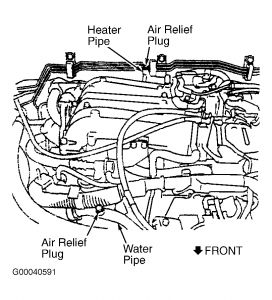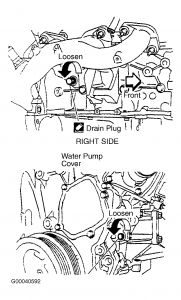To me sounds as its low on coolant
or u have an air trapped inside the engine I suggest follow coolant system bleeding steps below and also check the radiator cap
COOLING SYSTEM BLEEDING
WARNING: To avoid being scalded, never change engine coolant when engine is hot. Wrap a thick cloth around cap and carefully remove. First, turn a quarter turn to release built-up pressure, then turn cap all the way. Be careful not to allow engine coolant to contact drive belts.
1.Turn ignition switch to ON position. Set temperature control to maximum heat position. Turn ignition off after air mix door moves to HOT position.
2.Open radiator drain plug at bottom of radiator, and remove radiator cap. Remove reservoir tank and drain coolant. Clean reservoir tank. Remove cylinder block drain plugs and air relief plugs. See Fig. 1 and Fig. 2 . Check drained coolant for contaminants such as rust, corrosion or discoloration. If contaminated, flush engine cooling system.
3.Install reservoir tank, radiator drain plug and cylinder block drain plugs. Tighten fasteners to specification. Fill radiator slowly to allow air to escape. Install each air relief plug when coolant overflows. Tighten fasteners to specification. Fill coolant reservoir to MAX mark.
4.Start and warm engine to normal operating temperature without radiator cap installed. Run engine at 3000 RPM for 10 seconds and return to idle speed. Repeat 2-3 times. Turn engine off.
5.Check coolant level. Refill coolant reservoir to MAX mark, and repeat step 4 until coolant level no longer drops. Warm engine to normal operating temperature. Move heater control between COOL and HOT positions. Increase engine speed to 3000 RPM. Listen for coolant flow at heater valve. If coolant flow is heard, bleed air from cooling system by repeating step 4 until coolant level no longer drops. Check air relief and drain plugs for leaks.


Wednesday, May 1st, 2019 AT 3:29 PM
(Merged)




